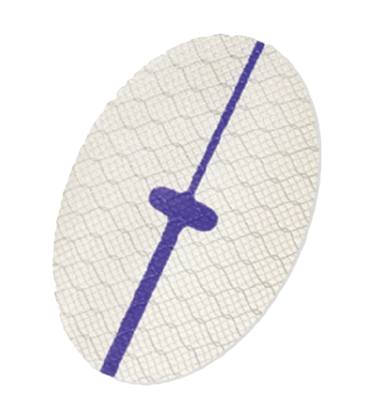Physiomesh is a brand of synthetic, shaped, hernia mesh manufactured by Ethicon, a leading business unit/subsidiary of the global drug, medical device, and consumer products giant, Johnson & Johnson (J&J). Current J&J CEO, Alex Gorsky, actually came to the company from Ethicon following its acquisition. In 2019, J&J’s highly profitable surgical device division reported $9.5 billion in sales worldwide.
Ethicon marketed its flexible composite Physiomesh as a device to aid with laparoscopic hernia procedures. However, due to thousands of reports of adverse surgical outcomes sent to the U.S. Food and Drug Administration (FDA), Ethicon voluntarily withdrew Physiomesh for laparoscopic procedures in 2016. As of today, at least 2,820 hernia patients who underwent procedures with Physiomesh are now claimants in multidistrict litigation alleging they have suffered injuries and pain resulting from their being implanted with the device.
Background and History of Physiomesh
The use of surgical mesh to repair hernias dates back to the late 19th century and today is one of the most common surgical procedures performed in the United States. Among modern hernia surgeries, a mesh is used in more than 80% and there are more than 70 types of mesh products available on the market.
Physiomesh is made with a non-absorbent, macroporous polypropylene material that was aggressively marketed for both open hernia repairs as well as minimally invasive laparoscopic surgeries. Physiomesh has a unique design incorporating five (5) layers: two layers of poliglecaprone-25 (“Monocryl”) film covering two underlying layers of polydioxanone film (“PDS”), which in turn coat the polypropylene mesh. Like the vast majority of mesh products available in the United States, Physiomesh was fast-tracked for sale through the FDA’s 510(k) Clearance process.
What is Laparoscopic Hernia Repair Surgery?
There are three main types of hernia repair surgery available in the United States: “open”; laparoscopic and robotic. Open hernia repair is a more traditional method and involves making a sizable incision in the groin, where a surgeon pushes a hernia back, closes the abdominal wall with sutures, and then closes the incision with multiple sutures.
Conversely, laparoscopic hernia repair is a minimally invasive procedure that uses a thin, telescopic instrument (known as a laparoscope) inserted through the patient’s belly-button under general anesthesia. The abdomen is then inflated with gaseous carbon dioxide and the mesh is placed on the inside of the abdominal wall. Once completed, the incision is closed with one or two sutures or surgical tape. The ostensible benefit of laparoscopic surgery is a reduction in scarring and a shorter recovery time.

Flexible Physiomesh Complications
The market for synthetic mesh products is both profitable and competitive. Additionally, synthetic mesh devices, like Physiomesh, are almost always routed through the FDA”s fast-track 510(k) clearance process which does not require manufacturers to support marketing applications with large amounts of safety and efficacy data. Consequently, these products make it onto the market and into our bodies without much scrutiny and potential complications are sometimes overlooked.
Post-market surveillance of flexible (laparoscopic) Physiomesh indicated defects causing premature disintegration, tissue adhesion, contraction, and organ perforation. Due to the number of post-market “adverse event” reports coming back to Ethicon and the FDA, Ethicon voluntarily withdrew the flexible version of its Physiomesh line from the market in 2016. The “open” version is still available on the market for ventral hernia repair.
Physiomesh Lawsuits
Starting in 2017, patients claiming they were injured and suffering from implantation with flexible Physiomesh filed the first initial lawsuits naming Ethicon and J&J. As these lawsuits began to accumulate and grow in number, they were consolidated into multidistrict litigation in federal court in Georgia (MDL-2782). Today there are thousands of claimants integrated into the MDL and the first “bellwether” cases are expected to commence in late 2020. In addition to the MDL, several state cases are proceeding on another track in New Jersey.
Sources Cited (15)
1) “Ethicon Physiomesh for Open Ventral Hernia Repair” https://www.jnjmedicaldevices.com/en-US/product/open-ventral-hernia-repair-physiomesh-hernia-mesh
2) “Ethicon Hernia Portfolio: Evidence Summary” https://www.jnjmedicaldevices.com/sites/default/files/user_uploaded_assets/pdf_assets/2019-10/Ethicon-Hernia-Portfolio-Evidence-008101-180511.pdf
3) “J&J’s Ethicon recalls Physiomesh flexible composite hernia mesh” https://www.massdevice.com/jjs-ethicon-recalls-physiomesh-flexible-composite-hernia-mesh/
4) “Hernia Mesh Lawsuits: History and Developments” https://www.nolo.com/legal-encyclopedia/hernia-mesh-lawsuits-history-and-developments.html
5) “EARLY CLINICAL OUTCOMES OF HERNIA REPAIR WITH PHYSIOMESH” https://www.sages.org/meetings/annual-meeting/abstracts-archive/early-clinical-outcomes-of-hernia-repair-with-physiomesh/
6) “MAUDE Adverse Event Report: ETHICON INC, PHYSIOMESH” https://www.accessdata.fda.gov/scripts/cdrh/cfdocs/cfmaude/detail.cfm?mdrfoi__id=2543604
7) “MAUDE Adverse Event Report: ETHICON PHYSIOMESH” https://www.accessdata.fda.gov/scripts/cdrh/cfdocs/cfMAUDE/detail.cfm?mdrfoi__id=2363232&pc=FTL
8) “The Importance of Registries in the Postmarketing Surveillance of Surgical Meshes” https://www.ncbi.nlm.nih.gov/pmc/articles/PMC6250300/
9) “Nationwide Long-term Outcome Surveillance of Physiomesh® vs. Other Meshes in Laparoscopic Incisional Hernia Repair” https://clinicaltrials.gov/ct2/show/NCT03846661
10) “Class 2 Device Recall Surgical mesh” https://www.accessdata.fda.gov/scripts/cdrh/cfdocs/cfres/res.cfm?id=138394
11) “Hernia Repair Surgery” https://my.clevelandclinic.org/health/treatments/17967-hernia-repair-surgery
12) “Open surgery better than laparoscopic for repair of inguinal hernia” https://www.ncbi.nlm.nih.gov/pmc/articles/PMC403835/
13) “LAPAROSCOPIC REMOVAL OF INGUINAL HERNIA MESH PLACED DURING A ROBOTIC TAPP HERNIA REPAIR IN A PATIENT WITH CHRONIC PAIN” https://www.sages.org/video/laparoscopic-removal-of-inguinal-hernia-mesh-placed-during-a-robotic-tapp-hernia-repair-in-a-patient-with-chronic-pain/
14) “Mind the gap: imaging spectrum of abdominal ventral hernia repair complications” https://www.ncbi.nlm.nih.gov/pmc/articles/PMC6439043/#:~:text=any%20abdominal%20surgery.-,Specific%20complications%20related%20to%20hernia%20repair%20include%20recurrent%20hernia%2C%20mesh,%2C%20fistula%20formation%2C%20and%20infertility.
15) “Johnson & Johnson: Annual Report 2019” https://www.investor.jnj.com/annual-meeting-materials/2019-annual-report


